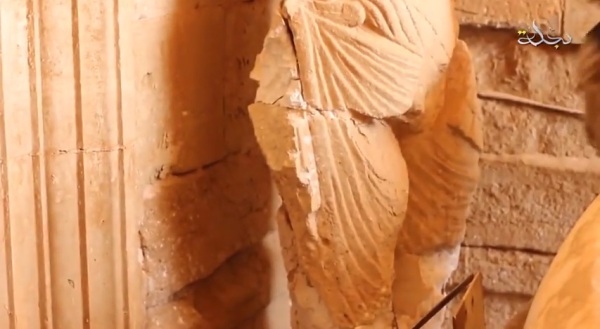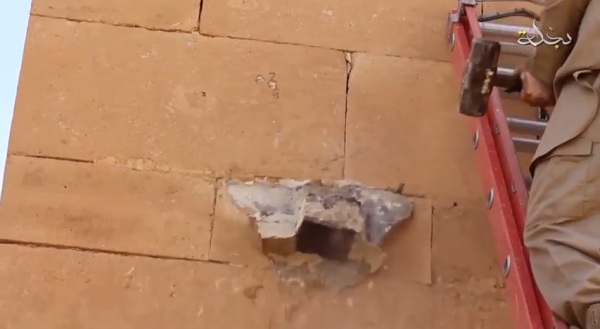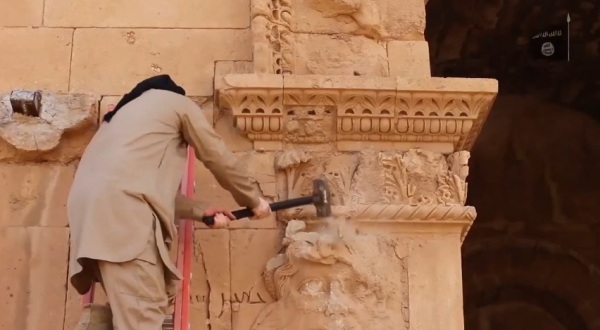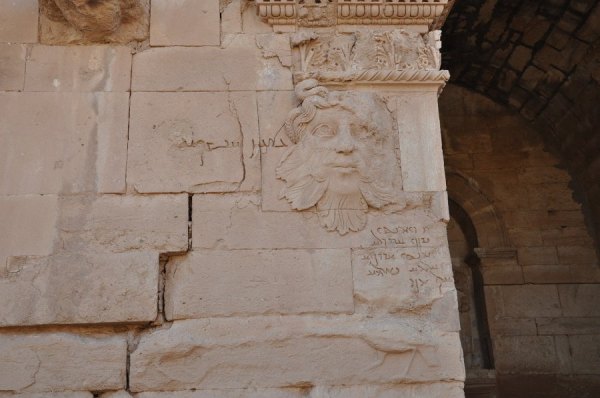In March this year reports swept through the global media that ISIS had used bulldozers to level the ancient city of Hatra. ISIS has already destroyed a number of irreplaceable sculptures from Hatra in the Mosul Museum, lending immediate credibility to reports from Iraqi antiquities officials that ISIS fighters had destroyed Hatra itself as well.
However, no videos or other confirmation surfaced for a month afterwards and there was no way to assess the extent of the damage. The story gradually faded from the media. Given the massive size of Hatra, and its location in the middle of the desert, in a region of no strategic significance, over fifty kilometers from inhabited areas, some grew skeptical that ISIS had mounted a major operation to demolish Hatra.
On Saturday video surfaced on YouTube and other websites which showed ISIS fighters destroying sculptures at Hatra. The voice-overs from several ISIS fighters contained the standard spiel about shirk, idolatry, and Muhammad destroying the idols of the Kaaba. The video was quickly removed, but I took some screenshots that will suffice illustrate the items which have been destroyed while leaving out the majority propaganda elements.
The good news is that the damage to Hatra is not as extensive was was first feared. The bad news is that more irreplaceable and unique Hatrene art has been damaged, threatening to further erase an already under-studied field.
At the beginning of the video there is an aerial shot of the ruins of Hatra which seems to have been shot from a blimp or drone. A graphic then highlights the Great Iwans and the Temple of the Triad with a label which reads “idols and statues.”
 All of the artifacts shown being destroyed in the video are from the Great Iwans. None are seen from the Temple of the Triad.
All of the artifacts shown being destroyed in the video are from the Great Iwans. None are seen from the Temple of the Triad.
Statues
Hatra was notable for its large number of life-sized or larger sculptures, especially in its major temples. The largest temple is a collection of massive arched rooms known as the Great Iwans, built in a Parthian style (other temples at the site are built in Hellenistic style, again showing Hatra’s importance as a fusion of East with West).
Two statues situated in an alcove closer to the ground are shown being attacked. First they chip away the reconstructed base of the statues with pickaxes, then smash the statues themselves with a large boulder.



 It is important to note that these statues are not reconstructions, but originals uncovered during excavations at Hatra and partially reconstructed at their bases. Here are the original publication photos from Safar and Mustafa’s Hatra: City of the Sun God.
It is important to note that these statues are not reconstructions, but originals uncovered during excavations at Hatra and partially reconstructed at their bases. Here are the original publication photos from Safar and Mustafa’s Hatra: City of the Sun God.
Sculptures of Heads
The Great Iwans had a number of human heads fixed on the exterior or built into the stonework. These are likewise not replicas but originals uncovered during excavations and restored to their original positions with the aid of steel bars. They break apart easily when hit by a sledgehammer because they break around the metal bar.
#1 –

A heavily eroded head at the entrance to the South Iwan (Iwan No. 12) Not identified amongst published material

Head above a relief of a snake. Outside the South Iwan (Iwan No. 12) Geschichte und Kultur einer Karawanenstadt im römisch-parthischen Mesopotamien (Mainz: Zabern, 2003), 71, fig. 99

Head situated between Iwan No. 4 and Iwan No. 12. Location identified by comparison to other parts of the video
This is a rather famous piece, thanks to the Aramaic inscription next to it which identifies it as grgn, or a Gorgon. Yet while Medusa the Gorgon from Greek mythology was female, this face has snake hair but also has leaves for a beard which indicates it is a male.[7]
It is unclear how much damage the relief sustained, as it was only shown in the video briefly being hit with a sledgehammer. It does appear to have suffered a broken nose and some damage around the eyes.
#5 –
These three heads are too high off the ground for any ISIS fighters to reach, but one fighter is shown shooting them with an AK-47 type rifle. The damage to the reliefs is unclear, but 7.62mm bullets likely do less damage to stone than sledgehammers and the shooting was done primarily for show.

Three heads in the back left corner of the South Iwan (Iwan No. 12). Geschichte und Kultur einer Karawanenstadt im römisch-parthischen Mesopotamien, 71, fig. 98
These heads were above ground and visible in ancient times. They survived for thousands of years in the open air. British explorer Gertrude Bell photographed them in April 1911 before major excavations took place at Hatra.
The Eagles
The South Iwan (Iwan No. 12) was lined with statues of eagles. Fragments of the eagles were found during excavations, restored, and placed back on the walls during reconstruction of the site during the 1960’s and 1980’s. A similar eagle from Hatra was destroyed in the Mosul Museum.[9]
Some of the eagles were attacked with pickaxes, while others were shot at with a PKM machine gun, breaking off their wings and heads.



 These eagles do not appear in Gertrude Bell’s 1911 photographs of the South Iwan, nor were most of them published in Safar and Mustafa.
These eagles do not appear in Gertrude Bell’s 1911 photographs of the South Iwan, nor were most of them published in Safar and Mustafa.
Conclusions
Based on this video it appears that the damage to Hatra was much less than originally feared. No major structural damage is depicted and the destroyed sculptures seem to be clustered around Iwans no. 12 and 4.
This would be a good time to note that these videos are highly produced and edited for propaganda purposes. It is entirely possible that other artifacts were destroyed which were not shown in the video. Their destruction may have been omitted for any number of reasons. The shots may have been blurry or from a bad angle. The footage may not have fit the pacing of the final production, which aims to show artifacts being smashed in seconds. If it took minutes to destroy a piece that could be a reason for editing it out.
It should also be noted that firing automatic firearms while standing inside a space enclosed on three sides by heavy stone walls is an incredibly stupid thing to do. Deadly ricochets would also not make for good propaganda filming. An ISIS fighter smashing his foot with a sledgehammer would also be cut out. We have no way of knowing what didn’t make it into the footage, only that the presentation is by its very nature selective.
Back in 2006, Al-Qaida in Iraq leader Abu Musab Zarqawi released a propaganda video of himself striding around the desert and firing a capture American M249 machine gun. The next month American troops raided a safe house and captured a laptop with the original unedited footage on its hard drive. American officers gave a press conference where they mocked Zarqawi while presenting the original video, which showed him struggling to aim the heavy weapon and unable to figure out how to clear a routine jam until others are forced to step into the frame to assist him. Their purpose in doing so was to undermine Zarqawi’s propaganda and the cult of personality and fear he built up around himself, and it worked. A similar find, if it exists, could counteract some of the propaganda value of ISIS’ videos of antiquities destruction.
Finally, there is a legitimate concern raised with increasing frequency about whether any publicity at all only helps ISIS achieve their propaganda goals. However, ISIS’ goals are not only to produce internet propaganda for consumption in the West, although that is a part of it. Most of ISIS’ acts of destruction have targeted Shia and Sufi religious sites, as has been extensively documented on this blog. Most of this has received little media coverage outside of the Middle East, yet they do it anyways. This seems to indicate that ISIS is not only acting to create media coverage but to erase the physical evidence of ideas and history whose existence stands in opposition to their own ideology. Documenting what was lost, while being careful not to endanger what survives, is the best way at our disposal to preserve the memory of what is being lost. Once something goes on the internet, it is never gone forever.
References:
[1] Fu’ad Safar and Ali Muhammad Mustafa, Hatra: The City of the Sun God [Arabic title al-Ḥaḍr, madīnat al-shams] (Baghdad: Wizarat al-Iʻlām, Mudīrīyat al-Athār al-ʻĀmmah, 1974), 95, pl. 54.
[2] Safar and Mustafa, Hatra: The City of the Sun God, 90-91, pl. 45-46.
[3] Not identified amongst published material.
[4] Michael Sommer, Hatra: Geschichte und Kultur einer Karawanenstadt im römisch-parthischen Mesopotamien (Mainz: Zabern, 2003), 71, fig. 99.
[5] Location identified by comparison to other parts of the video.
[6] Safar and Mustafa, Hatra: The City of the Sun God, 119.
[7] Klaas Dijkstra, “Does Gorgo Harm Us?: About the Interpretation of H106,” 171-183 in Hatra: Politics, Culture and Religion between Parthia and Rome, ed. by Lucinda Dirven (Stuttgart: Franz Steiner Verlag, 2013).
[8] Sommer, Hatra: Geschichte und Kultur einer Karawanenstadt im römisch-parthischen Mesopotamien, 71, fig. 98.
[9] The eagle from the Mosul Museum was published in Safar and Mustafa, Hatra: The City of the Sun God, 143, pl. 133. Another eagle was published on p. 144, pl. 134.Article © Christopher Jones 2015.
Originally published on Gates of Nineveh, republished with permission.



















